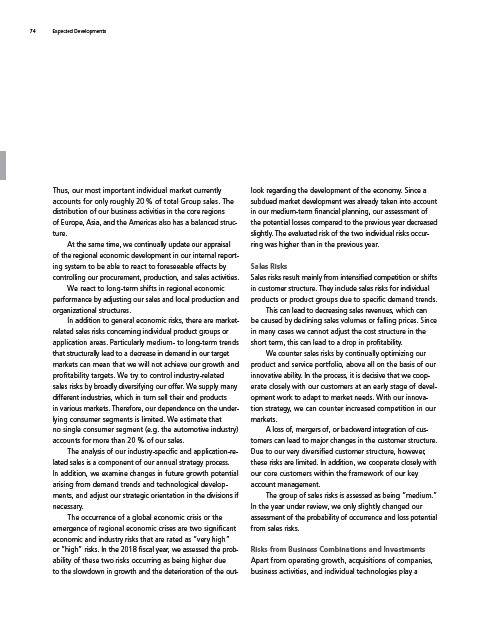
Thus, our most important individual market currently
accounts for only roughly 20 % of total Group sales. The
distribution of our business activities in the core regions
of Europe, Asia, and the Americas also has a balanced structure.
At the same time, we continually update our appraisal
of the regional economic development in our internal reporting
system to be able to react to foreseeable effects by
controlling our procurement, production, and sales activities.
We react to long-term shifts in regional economic
performance by adjusting our sales and local production and
organizational structures.
In addition to general economic risks, there are market-
related sales risks concerning individual product groups or
application areas. Particularly medium- to long-term trends
that structurally lead to a decrease in demand in our target
markets can mean that we will not achieve our growth and
profitability targets. We try to control industry-related
sales risks by broadly diversifying our offer. We supply many
different industries, which in turn sell their end products
in various markets. Therefore, our dependence on the underlying
consumer segments is limited. We estimate that
no single consumer segment (e.g. the automotive industry)
accounts for more than 20 % of our sales.
The analysis of our industry-specific and application-related
sales is a component of our annual strategy process.
In addition, we examine changes in future growth potential
arising from demand trends and technological developments,
and adjust our strategic orientation in the divisions if
necessary.
The occurrence of a global economic crisis or the
emergence of regional economic crises are two significant
economic and industry risks that are rated as “very high”
or “high” risks. In the 2018 fiscal year, we assessed the probability
of these two risks occurring as being higher due
to the slowdown in growth and the deterioration of the outlook
regarding the development of the economy. Since a
subdued market development was already taken into account
in our medium-term financial planning, our assessment of
the potential losses compared to the previous year decreased
slightly. The evaluated risk of the two individual risks occurring
was higher than in the previous year.
Sales Risks
Sales risks result mainly from intensified competition or shifts
in customer structure. They include sales risks for individual
products or product groups due to specific demand trends.
This can lead to decreasing sales revenues, which can
be caused by declining sales volumes or falling prices. Since
in many cases we cannot adjust the cost structure in the
short term, this can lead to a drop in profitability.
We counter sales risks by continually optimizing our
product and service portfolio, above all on the basis of our
innovative ability. In the process, it is decisive that we cooperate
closely with our customers at an early stage of development
work to adapt to market needs. With our innovation
strategy, we can counter increased competition in our
markets.
A loss of, mergers of, or backward integration of customers
can lead to major changes in the customer structure.
Due to our very diversified customer structure, however,
these risks are limited. In addition, we cooperate closely with
our core customers within the framework of our key
account management.
The group of sales risks is assessed as being “medium.”
In the year under review, we only slightly changed our
assessment of the probability of occurrence and loss potential
from sales risks.
Risks from Business Combinations and Investments
Apart from operating growth, acquisitions of companies,
business activities, and individual technologies play a
74 Expected Developments